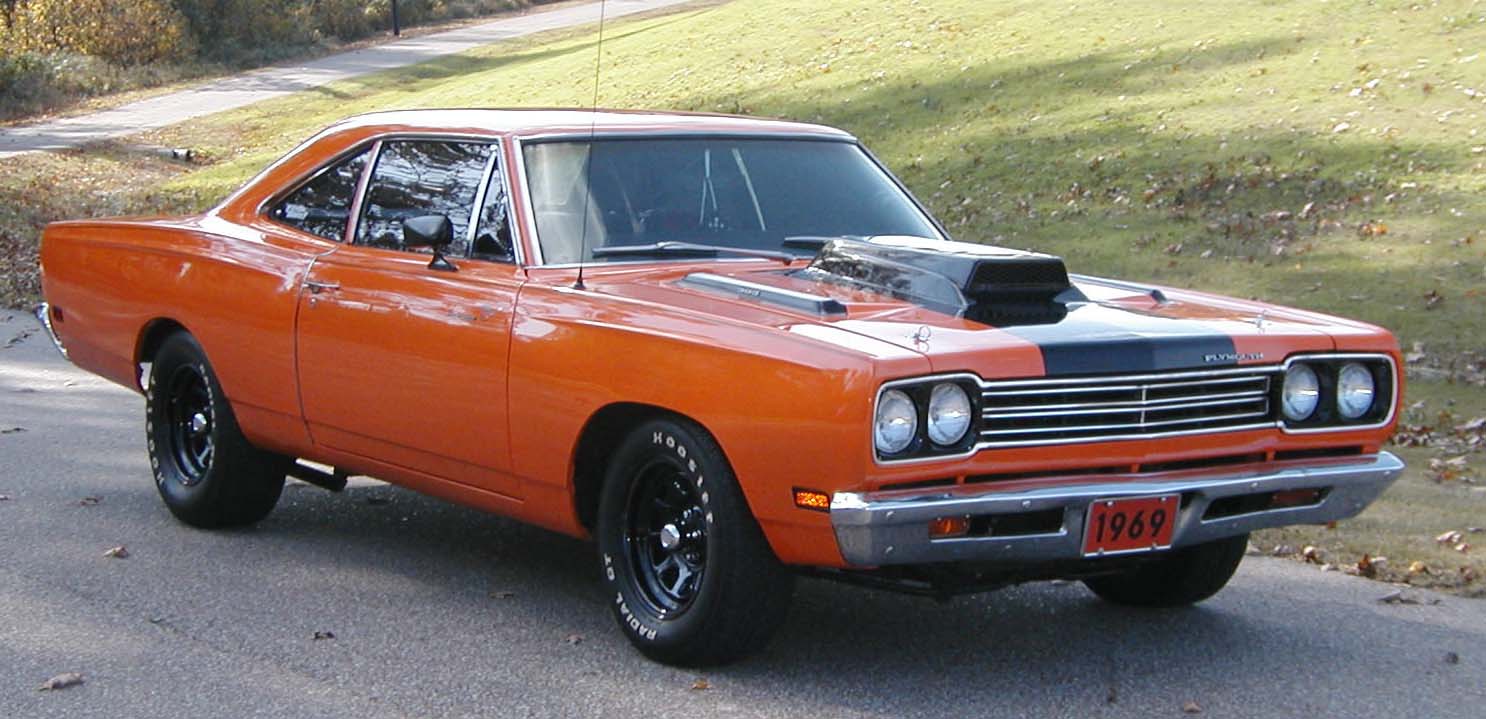

Developed specifically for NASCAR racing, the Superbird, a modified Plymouth Road Runner, and the Charger Daytona, a modified Dodge Charger 500, were among the first American cars to be designed aerodynamically using a wind tunnel and computer analysis. The Superbird's smoothed-out body and nosecone with retractable headlights added nineteen inches to the Road Runner's original length. A rear wing (spoiler) was mounted on tall tail-fins that put it into less disturbed air thus reducing the car's lighte clearance for the trunklid to open freely. The rear-facing fender scoops were used for releasing trapped air from the wheel wells.
A Mopar Orange Plymouth SuperbirdHowever, NASCAR's homologation requirement demanded that vehicles to be raced have to be available to the general public and sold in sufficient numbers. In 1970, NASCAR raised the production requirement from 500 examples to one for every 2 Manufacturer's dealers in the United States; for Plymouth, that meant having to build 1,920 Superbirds. 1970 would be its only production year.
"Superbird" decals were placed on the outside edges of the spoiler vertical fins featuring a picture of the Road Runner cartoon character holding a racing helmet. A smaller version of the decal appears on the driver side headlight door. The Superbirds came fitted with the 426 Hemi engine, the 440 Super Commando with a single 4-barrel carburetor, or the 440 Super Commando Six Barrel with three two-barrel carburetors. Only 135 models were fitted with the 426 Hemi. As the 440 was less expensive to produce, the 426 Hemi engine was homologated by producing a minimal number that was optioned in several different Chrysler, Dodge, and Plymouth vehicles.
On the street, the nosecone and wing were very distinctive, but the aerodynamic improvements hardly made a difference there or on the drag strip. In fact, the 1970 Road Runner was only slightly quicker in the quarter mile. At speeds in excess of 90 mph the differences were more obvious.
Petty's famous Road Runner Superbird on display at the Richard Petty MuseumIn Autumn 1968, Richard Petty left the Plymouth NASCAR Racing Team for Ford's. Charlie Grey, director of the Ford stock car program felt that hiring Petty would send the message that "money rules none". However, the Superbird lured Petty back to Plymouth for the 1970 season. Petty did reasonably well against strong Ford opposition on the NASCAR tracks that year, winning eight races and placing well in many more. A recent tribute to Petty's Superbird was seen in the 2006 film Cars with Petty voicing "The King", a stock race car bearing a strong resemblance to a Superbird.
NASCAR's rules implemented for the 1971 season limited the "aero-cars" to an engine displacement of no greater than 305 in³ (5.0 L) or they had to carry much more weight compared to their competitors. While they were still legal to race, the power-to-weight consequences that would come with the smaller engine or the increased weight rendered the cars uncompetitive. This was the start of a trend of rules slowing down NASCAR, because the races were exceeding the technology of tires and safety over 200 mph. Ford in response also designed the 1970 Torino King Cobra with a 240Z-like nose, but it was abandoned.
The Superbird's styling proved to be a little extreme for 1970 tastes (many customers preferred the regular Road Runner), and as a consequence, many examples sat unsold on the back lots of dealerships as late as 1972. Some were converted back into 1970 Road Runners to move them off the sales lot. In recent years, however, the Superbird has become quite valuable.
Appearing at the peak of the muscle car era, it is certainly one of the rarest and most desirable of muscle cars.

Beep - Beep!

Site Links






Links to MOPAR Restoration SItes
Herb's MOPAR Restoration & Performance PArts
Other Useful Automotive Information
The Impact of a Technology on Society: From 1865 - 1960
Jim's MOPAR Perfomance
B/E&A Restoration PArts's Inc.
Restoration Part's Sources
Hodge MOPAR Restorations
Automotive Dictionary
How Stuff Works
Dictionary of Automotive Terms
Edelbrock Industries
4-Stroke Engine Animation
Crane Cams (Is Back!)
Classic Car Ads